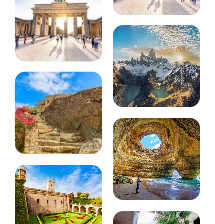
When to go to Santorini Climate, crowds and advice for each season
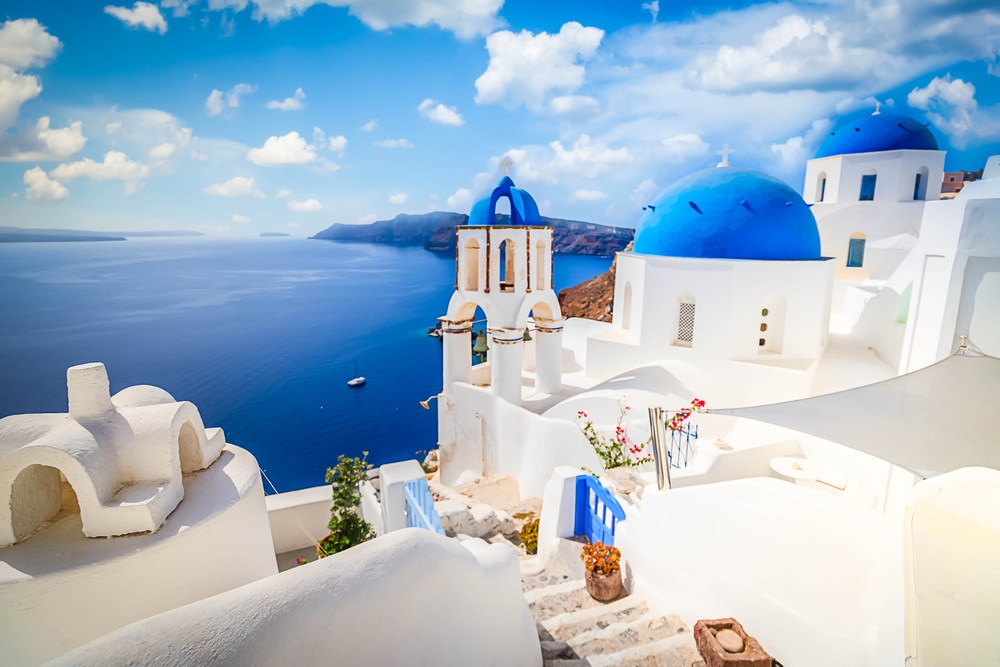
Santorini, the jewel of the Cyclades, fascinates visitors with its white houses perched on the caldera and its legendary sunsets. But when is the best time to visit Santorini? With its Mediterranean climate, crowds of tourists and price variations, choosing the ideal time to discover this iconic Greek island is worth considering. This comprehensive guide will help you plan your stay according to your expectations, whether you’re looking for peace and quiet, the best weather conditions or the lowest prices.

Read also about the Greece guide :
- The 20 most beautiful Greek islands to visit
- The 10 most beautiful beaches around Athens
- Top 10 things to do in Athens
- Visit the Saronic Islands, off the coast of Greece
- Top 12 culinary specialities in Athens
1. Santorini’s year-round climate
Santorini enjoys a Mediterranean climate typical of the Cyclades, with hot, dry summers and mild winters. This climatic configuration makes the island accessible practically all year round, although some periods are more favourable than others, depending on your expectations. The average annual temperature is around 20°C, with notable variations between seasons.
Rainfall is mainly concentrated between November and March, with January being the wettest month, recording around 70mm of rain. From May to September, on the other hand, rainfall is almost non-existent, offering generous sunshine of around 12 hours a day at the height of summer. The Aegean Sea that surrounds Santorini reaches its maximum temperature in August at 25°C, perfect for swimming.
A characteristic feature of Santorini’s climate is the meltémi, a northerly wind that blows particularly in July and August. Although it pleasantly cools the hot summer days, it can sometimes disrupt ferry crossings to the other Cycladic islands. This meteorological phenomenon nevertheless helps to keep temperatures bearable even in the height of summer.
2. Visit Santorini in spring (April to May)
Spring is undoubtedly one of the best times to visit Santorini. Between April and May, the island slowly awakens from its winter torpor, revealing a side of Santorini little-known to summer tourists. Temperatures fluctuate between 19°C and 22°C, ideal for exploring hilltop villages such as Oia (rated 4.7/5 on Google with over 50,000 reviews) and Fira without the oppressive heat of summer.
This period offers the major advantage of avoiding the massive crowds that descend on the island from June onwards. The narrow streets regain their authenticity, the local restaurants can welcome visitors without prior reservation, and the famous sunsets can be admired in a much more intimate atmosphere. The vegetation, still green from the spring rains, contrasts magnificently with the whitewashed houses and characteristic blue domes.
Prices in the shoulder season are still much more affordable than in the high season. Accommodation is up to 40% cheaper than in July and August, and flights to Santorini are also more affordable. In April in particular, hiking enthusiasts can take full advantage of the panoramic path linking Fira to Oia, a 10-kilometre walk offering spectacular views of the caldera, without the stifling summer heat.
Beware, however, as the sea remains cool, with temperatures hovering around 17-18°C in April and 19-20°C in May. If swimming is an absolute priority during your stay, this period may not be suitable for the most frigid, although the bravest will appreciate these refreshing conditions.
3. Visit Santorini in summer (June to September)
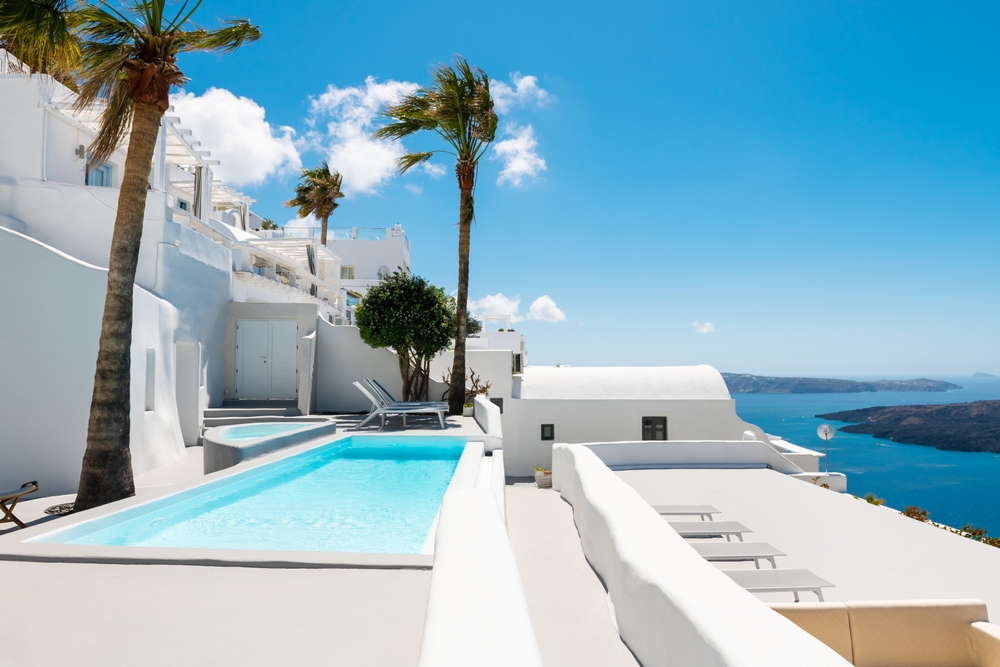
Summer is Santorini’s peak tourist season, when the island is alive with thousands of visitors from all over the world. From June to September, the thermometer regularly registers 28-30°C, with peaks of up to 35°C in July and August. The Aegean Sea gradually warms to an ideal temperature of 24-25°C, perfect for enjoying volcanic beaches such as the famous Red Beach at Akrotiri (rated 3.6/5 on Google for 6,400 reviews) or the black beach at Perissa.
This is the busiest time of the year, with all the bars, restaurants and shops open. Water sports activities are in full swing: catamaran excursions around the caldera, scuba diving, jet-skiing… Oia’s famous sunsets attract hundreds of spectators every evening, creating a festive but sometimes stifling atmosphere. For nightlife lovers, Fira comes alive until the early hours with its trendy bars and clubs.
Nevertheless, this massive influx has several major drawbacks. Prices soar: you can easily double or even triple the price of accommodation compared with other seasons. Reservations must be made several months in advance, otherwise you’ll find only overpriced or low-quality options. Tourist sites such as the archaeological site of Akrotiri (rated 4.2/5 on Google for 5,800 reviews) become overcrowded, and waits for access to well-known restaurants can exceed an hour.
If you still choose this period, choose June or September rather than the height of summer. These pivotal months offer an interesting compromise, with temperatures that are still pleasant, the sea warm and the crowds slightly less oppressive than in July and August.
4. Visit Santorini in autumn (September to October)
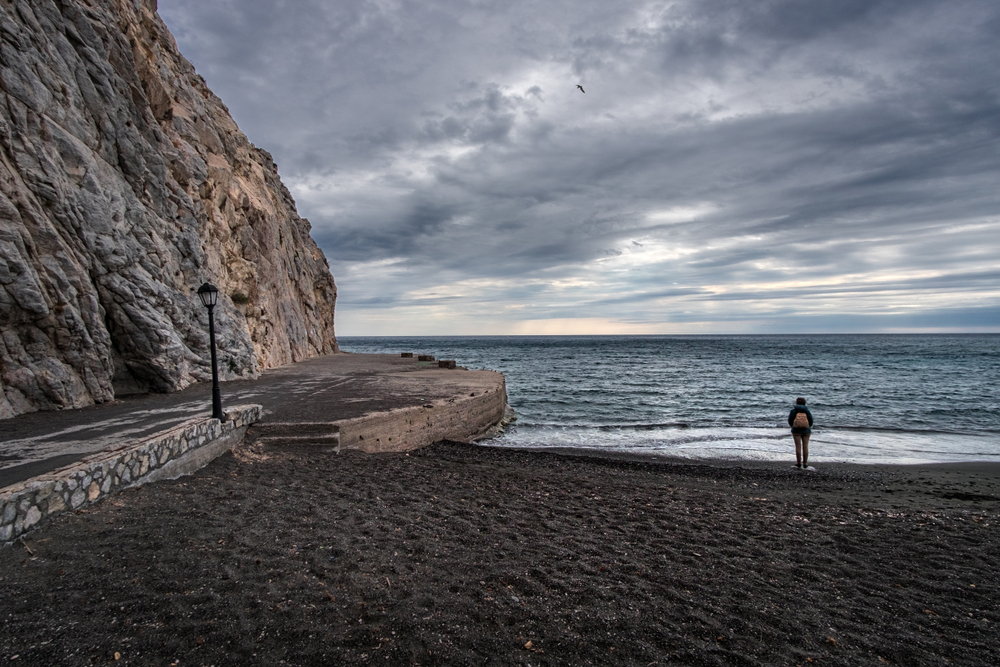
Autumn, particularly September and October, is one of the best times to discover Santorini in optimum conditions. September cleverly combines the advantages of summer without its main disadvantages: the sea remains a pleasant 23-24°C, sunshine remains generous with around 10 hours a day, and temperatures oscillate between 22 and 26°C, ideal for all activities.
The beginning of September marks the gradual end of the high season, with a noticeable drop in tourist numbers from mid-September onwards. The villages gradually regain their tranquillity, queues shorten considerably and the general atmosphere becomes more authentic and relaxed. This is the time to fully appreciate the charms of Santorini without the constant pressure of the tourist hordes.
October confirms this trend, with weather that is still mild, albeit more capricious. Temperatures drop slightly to stabilise at around 18-23°C, and a little rain may fall at the end of the month. The sea is still swimmable, however, at 21°C in early October. This is the ideal time of year for hikers who want to explore the coastal paths without suffering from the heat, particularly the magnificent path linking Fira to Oia.
Prices are gradually coming down from the beginning of September, with reductions of up to 40% in October compared with August prices. Hotel and guesthouse owners are becoming more flexible, and last-minute bookings can lead to some excellent surprises. Flights from France are also becoming more affordable, although some direct connections are becoming rarer from October onwards.
5. Visit Santorini in winter (November to March)
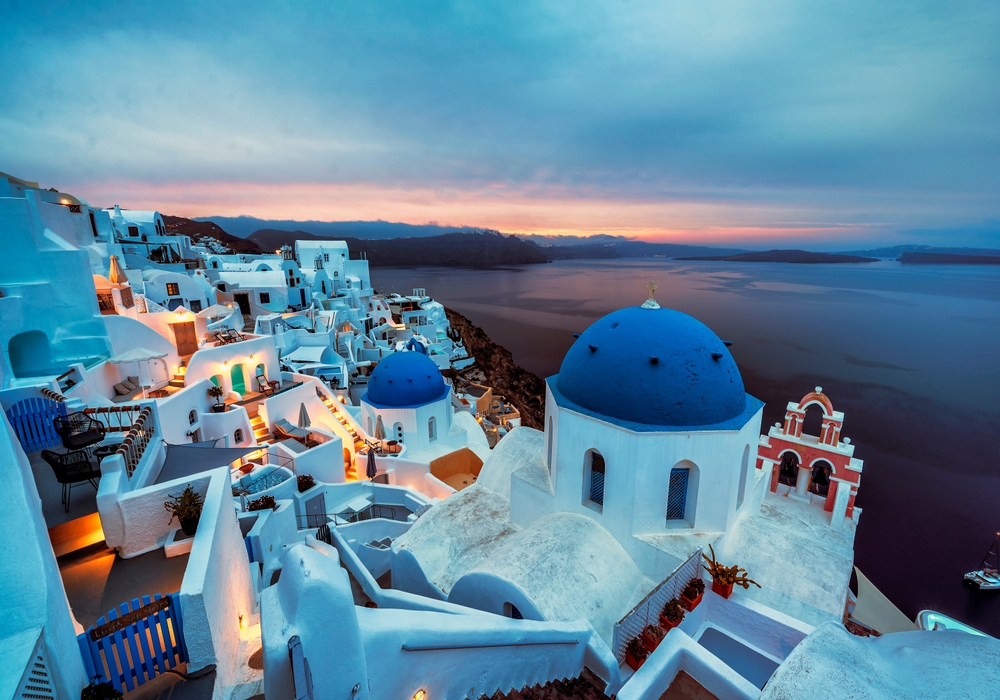
Winter on Santorini reveals a totally different side of the island, far from the picture-postcard image of summer. From November to March, temperatures vary between 10 and 15°C, with occasional rainy and windy days. Most of the rain falls in January, with around 70 mm, although there is still around 5 hours of sunshine a day even during this season.
This low season radically transforms the island’s atmosphere. Almost all the tourists disappear, making way for the permanent residents, who number barely 15,000. Many tourist establishments close their doors, particularly in Oia and the areas that are most popular in summer. However, Fira and inland villages such as Pyrgos are maintaining their authentic local character.
Visiting Santorini in winter allows you to discover the true soul of the Greek island. The alleyways are absolutely quiet, the café terraces are mainly populated by locals, and the architecture is revealed without the constant influx of visitors. It’s the ideal time of year for photographers looking for unique shots, without selfie-sticks or crowds in front of every panorama. Sunsets can be admired in complete serenity from the usually crowded vantage points.
Rates are at their lowest level of the year, with reductions of up to 60% on accommodation. Some hotels are even offering very attractive long-term packages. Beware, however, as air services are becoming much scarcer, and ferries may be cancelled in rough seas. Swimming becomes impossible at sea temperatures of around 15-16°C.
6. The best times for your priorities
Choosing the best time to visit Santorini basically depends on your priorities and expectations for this trip to the Cyclades. For a seaside holiday focused on beaches and swimming, June and September are the ideal months, combining warm seas (23-25°C), generous sunshine and fewer crowds than July and August. These months allow you to make the most of Santorini’s magnificent beaches while avoiding the summer overcrowding.
Travellers looking above all for tranquillity and authenticity should favour April-May or October-November. These mid-season periods offer the best compromise between acceptable weather conditions and reasonable tourist numbers. You can stroll through the narrow streets of Oia without being rushed, sample the local cuisine in the traditional tavernas without a reservation, and discover Greek culture in all its authenticity.
For those on a tight budget, winter (December to February) offers the most attractive rates, up to 60% cheaper than high season. Although the weather can be fickle, this period is ideal for photography enthusiasts and independent travellers looking for an off-the-beaten-track experience. The months of November and March are interesting alternatives, with prices still lower and the climate milder than in the middle of winter.
Fans of hiking and nature activities will be delighted from April to June and from September to October. These periods offer perfect temperatures for walking the island’s trails without suffering from the heat, particularly the famous panoramic path from Fira to Oia. Spring vegetation adds an unusual touch of greenery to the volcanic landscape, creating striking photographic contrasts.
7. Events and festivals not to be missed
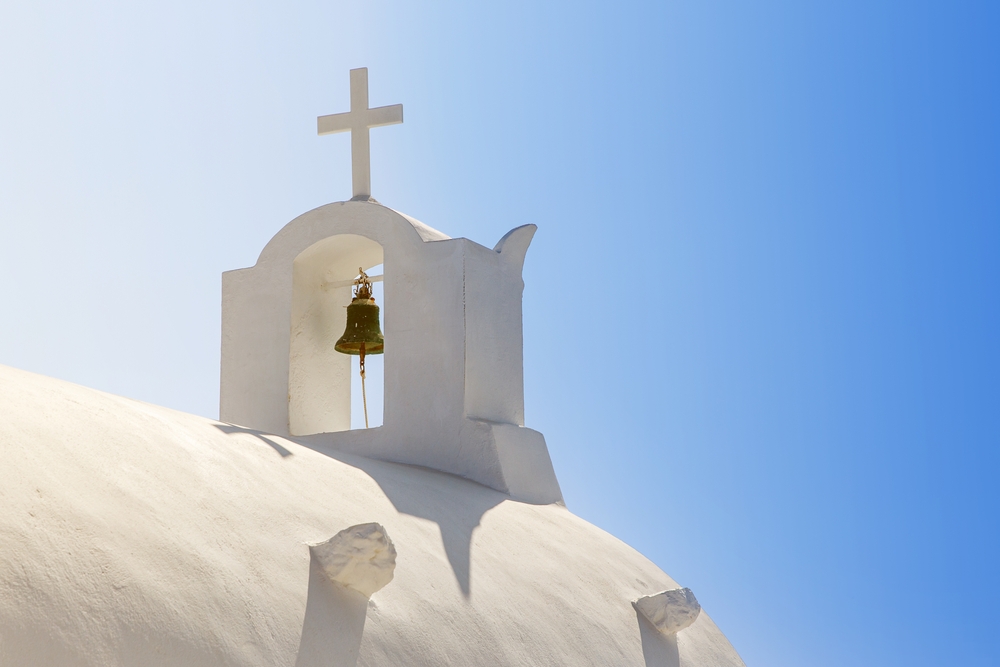
As well as climatic and tourist considerations, there are a number of cultural events that may influence your choice of time to visit Santorini. Orthodox Easter, which generally takes place in April or May according to the Julian calendar, is the most important religious celebration of the year in Greece. Santorini’s churches, particularly in Pyrgos, are lit up with thousands of candles during the nightly procession on Holy Saturday, creating a mystical and moving atmosphere.
The Santorini International Music Festival, usually held at the beginning of September, attracts world-renowned artists in an exceptional setting. Concerts take place in iconic locations such as the archaeological site of Akrotiri and the panoramic terraces of Fira, offering a unique cultural experience combining classical music and the breathtaking scenery of the caldera.
The festival of Agia Irini, patron saint of the island from which Santorini takes its modern name, is celebrated on 5 May in several villages, including Perissa. This traditional local festival features religious processions, folk dancing and community banquets where visitors are warmly welcomed. It’s a unique opportunity to discover authentic Greek customs far from mass tourism.
In July, the Kamari Open-Air Film Festival transforms the beach into a giant screening room, with Greek and international films shown under the stars. This original cultural initiative allows you to enjoy an evening of cinema in an exceptional natural setting, with your feet in the black volcanic sand that is so characteristic of this beach.
8. Practical tips for booking at the best time
Planning and booking at the right time can generate substantial savings for your trip to Santorini. For the high season (July-August), anticipation is crucial: ideally book 4 to 6 months in advance to benefit from the best rates and the widest selection of accommodation. After that, prices gradually rise and the best-located establishments, particularly in Oia and Imerovigli, sell out.
For the mid-season periods (April-May and September-October), 2 to 3 months’ notice is generally sufficient. These periods offer greater flexibility, and last-minute offers can sometimes provide some excellent surprises, particularly in October when the crowds thin out rapidly. Keep an eye out for special offers from low-cost airlines flying to Santorini from a number of European cities.
Winter and the very low season allow more spontaneity. Some travellers manage to negotiate advantageous rates directly with accommodation owners, especially for stays of several weeks. Flights, although less frequent, often offer unbeatable prices. Don’t hesitate to contact the hotels directly by email rather than going through the booking platforms to get the best deals.
For ferries between Athens and Santorini or between the various islands of the Cyclades, book your tickets as soon as your dates are confirmed, especially for journeys in July and August. Fast ferries (lasting 5 hours) quickly sell out in the most popular time slots. Tickets bought locally or at the last minute generally cost 20-30% more.
In conclusion, the best time to visit Santorini varies according to your personal priorities. May, June, September and October generally offer the best balance between pleasant weather conditions, controlled crowds and reasonable prices. These periods allow you to take full advantage of the wonders of this iconic Greek island: its perched villages with white houses and blue domes, its spectacular caldera, its unique volcanic beaches and its legendary sunsets. Whether you’re looking for spring tranquillity, summer excitement or winter authenticity, Santorini will win you over and leave a lasting impression on your memories of your trip to the Cyclades. Plan your holiday carefully, book well in advance and get ready to discover one of the most fascinating destinations in the Mediterranean.
FAQ : When is the best time to visit Santorini?
What’s the best month to visit Santorini?
May, June, September and October are considered the best months to visit Santorini. They combine pleasant temperatures (20-26°C), moderate tourist numbers and reasonable prices. June and September have the added advantage of warm seas, making them ideal for swimming.
Can you swim on Santorini all year round?
Swimming in Santorini is comfortable from June to October, when the sea temperature varies between 21°C and 25°C. In May and November, the water remains cool (18-20°C), but is still suitable for the more courageous. From December to April, the sea temperature drops below 17°C, making swimming less pleasant.
When is the cheapest time to go to Santorini?
Winter, from November to March, offers the lowest fares, with reductions of up to 60% compared with the high season. November and March represent a good compromise, with attractive prices and a milder climate than January-February. April and October also offer attractive rates, around 40% cheaper than in summer.
When is Santorini least crowded?
The period from November to March sees the lowest tourist numbers, with the island almost deserted by visitors. April and October also see moderate visitor numbers. July and August, on the other hand, are the busiest months, with over 5 million visitors in some cases over the whole summer season.
Should you avoid Santorini in July and August?
July and August are not to be avoided systematically, but these months have some major drawbacks: maximum crowds, very high prices, intense heat and crowded sites. If you must go during this period, opt for inland villages such as Pyrgos or Megalochori, which are less crowded than Oia and Fira, and book several months in advance.
200 audioguided tours for cities all around the world
Download